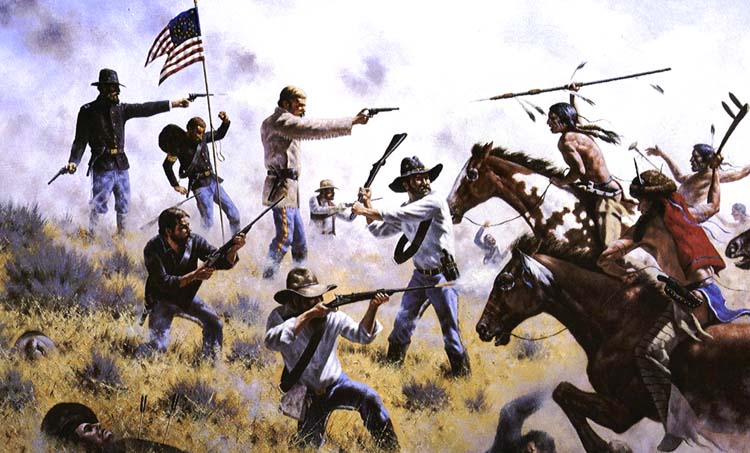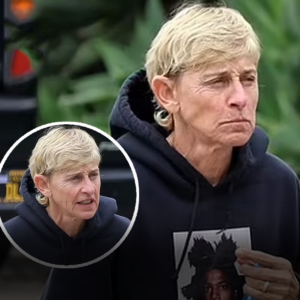What Really Happened at the Battle of the Little Bighorn?
Under skies darkened by smoke, gunfire and flying arrows, 210 men of the U.S. Army’s 7th Cavalry Unit led by Lt. Colonel George Custer confronted thousands of Lakota Sioux and Northern Cheyenne warriors on June 25, 1876, near the Little Big Horn River in present-day Montana. The engagement was one in a series of battles and negotiations between Plains Indians and U.S. forces over control of Western territory, collectively known as the Sioux Wars.
In less than an hour, the Sioux and Cheyenne had won the Battle of the Little Bighorn, killing Custer and every one of his men. The battle has been ennobled as “Custer’s Last Stand”—but in truth, Custer and his men never stood a fighting chance.

Battle of the Little Bighorn
Custer’s Early Life Was Less Than Auspicious
George Armstrong Custer, born in Ohio in 1839, earned a certificate for teaching grammar school in 1856 but had much grander goals. The following year, he entered the U.S. Military Academy at West Point, where he was a less-than-stellar cadet: Custer graduated dead last in his class of 1861.
When the Civil War broke out in April 1861, Custer joined the Union Army’s Cavalry and soon proved himself a competent, reliable soldier in battles such as the First Battle of Bull Run and the Battle of Gettysburg. He was promoted several times and by the time the war ended, he was a Major General in charge of a Cavalry division.
First Battle of Bull Run
Throughout the war, Custer showed resilience time and again. He supposedly had 11 horses shot out from under him yet was only wounded once. His dogged pursuit of the Army of Northern Virginia is often partially credited for helping to end the Civil War.
Custer was never afraid of getting his hands dirty. Unlike many other generals, he led his men from the front instead of from behind and was often the first to plunge into battle.
In February 1864, Custer married Elizabeth (Libbie) Bacon. In 1866, he was promoted to Lt. Colonel in charge of the 7th U.S. Cavalry Unit and went with Libbie to Kansas to fight in the Plains Indian Wars.
The Plains Indians Show Tremendous Fortitude
Three young Native American men, probably Sioux, wearing native accessories, 1899. (Photo by Heyn/Buyenlarge/Getty Images)
Heyn/Buyenlarge/Getty Images
Three young Native American men, probably Sioux, 1899.
The Great Plains were the last Native American holdout in America. As settlers colonized the far west before the Civil War, few had put down roots in the Plains due to its dry weather and large Indigenous populations.
But after the Civil War, far-west land became scarcer and the U.S. government granted 10 percent of Plains land to settlers and railroads. A confrontation between the Plains Indians against the settlers and government forces was inevitable.
By the late 1860s, most Native Americans had been forced onto so-called Indian reservations or killed outright. Vowing to avoid the same fate, the Plains Indians settled in for a long and fierce holdout.
In the hopes of squashing the livelihood of the Native American people on the Plains, the government allowed the railroads to kill scores of buffalo herds to lay railroad tracks. They also urged hunters to kill as many buffalo as possible without oversight and encouraged trains to stop so passengers could massacre buffalo for sport.
The more the white colonizers needlessly slaughtered buffalo, the angrier Indigenous people grew. Some staged brutal attacks on settlers and railroad workers without regard to age or gender.
To the tribes, the railroad represented an end to their livelihood, since for millennia they’d relied on free-roaming buffalo to survive. By the time Custer arrived on the scene in 1866, the war between the army and the Plains Indians was in full force.

Portrait of General Winfield Scott Hancock (1824-1886), a Federal officer during the American Civil War, with members of his staff. Left to right are Generals Francis C. Barlow, David B. Birney, Winfield S. Hancock (seated), and John Gibbon. Each of these officers was wounded during the Battle of Gettysburg. (Photo by © CORBIS/Corbis via Getty Images)
CORBIS/Corbis via Getty Images
Portrait of General Winfield Scott Hancock (1824-1886), a Federal officer during the American Civil War, with members of his staff. Left to right are Generals Francis C. Barlow, David B. Birney, Winfield S. Hancock (seated), and John Gibbon. Each of these officers was wounded during the Battle of Gettysburg.
Custer Goes AWOL and Is Court-Martialed by the U.S. Army.
Custer’s first assignment was helping Major General Winfield S. Hancock carry out a shock-and-awe campaign to overwhelm the tribal nations. At the end of the campaign, Custer deserted and joined his wife at Fort Riley. He was court-martialed in 1867 and suspended without rank and pay for one year.
The fact that Custer—a highly-decorated and well-respected commander—deserted perplexed many of his men and his superiors. It also demonstrated his inclination to make rash decisions, a trait that some say would have deadly consequences later.
Despite Custer’s now-tarnished reputation, the army still needed him to fight Native Americans. In September 1868, he returned to duty before his court-martial sentence was up and resumed command of the 7th Cavalry. On November 28, he led a campaign against a village of Cheyenne led by Chief Black Kettle, killing all Native American warriors present and earning himself a reputation as a ruthless fighter.
Over the next several years, Custer discovered that fighting Indigenous people was much different than fighting Confederate soldiers.
The Indigenous warriors were spread out. They rode fast ponies and knew the terrain better than Custer ever could.
1887: Native American hunters pursue a herd of bison across the plains. Original Artwork: Painting by Charles Marion Russell. (Photo by MPI/Getty Images)
MPI/Getty Images
1887: Native American hunters pursue a herd of bison across the plains. Original Artwork: Painting by Charles Marion Russell.
Sitting Bull and Crazy Horse: Battle-Hardened Warriors
In 1873, Custer faced a group of attacking Lakota at the Northern Pacific Railroad Survey at Yellowstone. It was his first encounter with Lakota leaders Sitting Bull and Crazy Horse, but it wouldn’t be his last. Little did Custer know at the time the two Indigenous leaders would play a role in his death a few years later.
In 1868, the U.S. government signed a treaty recognizing South Dakota’s Black Hills as part of the Great Sioux Reservation. However, the government had a change of heart and decided to break the treaty in 1874 when Custer led an excursion of miners who had been looking for gold into the Black Hills.
Custer was tasked with relocating all Native Americans in the area to reservations by January 31, 1876. Any person who didn’t comply would be considered hostile.
The Native Americans, however, didn’t take the deception lying down. Those who could, left their reservations and traveled to Montana to join forces with Sitting Bull and Crazy Horse at their fast-growing camp. Thousands strong, the group eventually settled on the banks of the Little Bighorn River.
Background to the Battle of the Little Bighorn
The U.S. Army dispatched three columns of soldiers, including Custer and his 7th Cavalry, to round up Indigenous people and return them to their reservations.
The plan was for Custer’s cavalry and Brigadier General Alfred Terry’s infantry to rendezvous with troops under the command of Colonel John Gibbon and Brigadier General George Crook. They’d then find the Native Americans, surround them and force their surrender.
Crook was delayed but Terry, Custer and Gibbon met up in mid-June and after a scouting party found a trail headed toward Little Big Horn Valley, they decided Custer should move in, surround the tribes and await reinforcements.
Custer forged ahead but things didn’t go as planned. Around midday on June 25, his scouts located Sitting Bull’s camp. Instead of waiting for reinforcements, however, Custer planned a surprise attack for the next day. He moved it up when he thought the Native American forces had discovered his position.
Custer divided his more than 600 men into four groups. He ordered one small battalion to stay with the supply train and the other two, led by Captain Frederick Benteen and Major Marcus Reno, to attack from the south and prevent the tribesman from escaping. Custer would lead the final group—210 men strong—and planned to attack from the north.
Reno’s group attacked first but swiftly embarked on a disorganized retreat after realizing they were completely outnumbered. By the time they’d regrouped, at least 30 troops were dead.
Benteen’s troops came to Reno’s aid and the combined battalions joined forces on what is now known as Reno Hill. They remained there despite Custer’s order: “Benteen. Come on, Big Village, Be quick, Bring packs. P.S. Bring packs.”
At the 10-year memorial of the Battle of Little Bighorn, unidentified Lakota Sioux dance in commemoration of their victory over teh United States 7th Cavalry Regiment (under General George Custer), Montana, 1886. The photograph was taken by S.T. Fansler, at the battlefield’s dedication ceremony as a national monument. (Photo by Transcendental Graphics/Getty Images)
Transcendental Graphics/Getty Images
At the 10-year memorial of the Battle of Little Bighorn, unidentified Lakota Sioux dance in commemoration of their victory over the United States 7th Cavalry Regiment (under General George Custer), Montana, 1886. The photograph was taken by S.T. Fansler, at the battlefield’s dedication ceremony as a national monument.
Custer’s ‘Last Stand’ Becomes a Slaughter
The exact events of Custer’s Last Stand are unclear. What is known is that neither Benteen or Reno helped Custer despite admitting later they’d heard heavy gunfire coming from Custer’s position. Custer and his men were left to face scores of Native American warriors alone. Some historians believe many of Custer’s men panicked, dismounted from their horses and were shot dead as they fled.
No one knows when Custer realized he was in trouble since no eyewitness from his troops lived to tell the tale. The Sioux and Cheyenne warriors led by Crazy Horse attacked with Winchester, Henry and Spencer repeating rifles as well as bows and arrows.
Most of Custer’s men were armed with Springfield single-shot carbine rifles and Colt .45 revolvers; they were easily outgunned. Custer’s line and command structure quickly collapsed, and soon it was every man for himself.

Custer Dies by Two Bullet Wounds
In the end, Custer found himself on the defensive with nowhere to hide and nowhere to run and was killed along with every man in his battalion. His body was found near Custer Hill, also known as Last Stand Hill, alongside the bodies of 40 of his men, including his brother and nephew, and dozens of dead horses.
Custer had suffered two bullet wounds, one near his heart and one in the head. It’s unclear which wound killed him or if the head wound happened before or after he died. In the heat of battle, it’s unlikely the warrior who shot Custer knew he’d just killed a U.S. Army icon. Even so, once word spread that Custer was dead, many Native Americans claimed to be his executioner.
After the battle, Native American warriors stripped, scalped and dismembered their enemy’s corpses on the battlefield, possibly because they believed the souls of disfigured bodies were doomed to walk the earth forever.
Reaction to the Little Big Horn Spells Doom for the Plains Indians
The Battle of the Little Big Horn didn’t end with the massacre of Custer and his men. The Native Americans quickly regrouped and pursued Reno’s and Benteen’s battalions. The troops fought until General Terry’s reinforcements finally arrived.
Now it was the Native Americans who were outnumbered so they packed up camp and fled, bringing the largest defeat of the U.S. Army during the Plains Indian Wars to an end.
The Sioux and Cheyenne reveled in their victory for a time, but their celebration was short-lived, as was their freedom. When word of Custer’s death reached Americans celebrating their nation’s centennial on July 4, they demanded retribution.
The U.S. Army intensified its efforts to hunt down all resisting Native Americans and either wipe them out or force them back onto reservations. Within a year, most had been rounded up or killed.
In May 1877, Crazy Horse surrendered at Fort Robinson, Nebraska, where he was later bayoneted and killed after an altercation with an army officer. After fleeing to Canada, Sitting Bull eventually surrendered in 1881 and lived on Standing Rock Reservation until he was killed by Native American agent policemen during a conflict at his house in 1890.
25th June 1876: General Custer with his men from the 7th Cavalry at the Battle of Bighorn being defeated by the combined forces of the Sioux-Cheyenne Indians. (Photo by Hulton Archive/Getty Images)
Hulton Archive/Getty Images
June 25, 1876: General Custer with his men from the 7th Cavalry at the Battle of Bighorn being defeated by the combined forces of the Sioux-Cheyenne warriors.
‘Custer’s Last Stand’ Becomes a Manufactured Legacy
The Battle of the Little Bighorn—aka Custer’s Last Stand—is steeped in controversy. To this day, many people question his actions that fateful day. He’s often accused of arrogance for not following the original battle plan and leading his men to certain death. Yet it’s possible Custer believed reinforcements were on the way and wanted to strike before the Sioux and Cheyenne dispersed; it’s unlikely he expected such a well-armed attack.
It’s also argued that Reno and Benteen were simply cowards who ignored Custer’s orders when the fighting unexpectedly got tough, leaving Custer and his men to fight a losing battle. In their defense, though, they may have believed that following Custer’s orders was a suicide mission.
The dead at the Battle of the Little Big Horn were given a quick burial where they fell by the first soldiers who arrived at the scene. Custer was later disinterred and reburied at West Point. Other troops were also disinterred for private burials.
In 1881, a memorial was erected in honor of those who lost their lives. A trench was dug below the memorial to re-inter the remaining battlefield remains and a marker was erected where each soldier had fallen in battle.
While Custer never had the chance to defend his actions at the Battle of Little Big Horn, he needn’t have worried about his legacy because his widow Libbie had it safely in hand: She wanted her husband to go down in honor and boldly promoted him as a brave hero cut down in the prime of his life while defending his country.
It seems Libbie Custer’s efforts paid off. No matter how it’s interpreted over 140 years later, the Battle of Little Big Horn is still one of the most recognized events in U.S. history.
News
The “Red Zone” – Land Still Abandoned Due to the Dangers Left by the First World War
The “Red Zone” – Land Still Abandoned Due to the Dangers Left by the First World War In the aftermath of the First World War, large areas of northeast France were left in ruin. Years of constant siege warfare along…
Before Becoming a Big-Name Actor, Richard Todd was a Paratrooper Who Fought at Pegasus Bridge
Before Becoming a Big-Name Actor, Richard Todd was a Paratrooper Who Fought at Pegasus Bridge Photo Credit: 1. Sgt. Christie, No. 5 Army Film & Photographic Unit / Imperial War Museums / Wikimedia Commons / Public Domain 2. Silver Screen…
The Potsdam Giants: A Prussian Infantry Regiment Of Nothing But Very Tall Soldiers
The Potsdam Giants: A Prussian Infantry Regiment Of Nothing But Very Tall Soldiers Frederick William I inspecting his giant guards known as The Potsdam Giants, a Prussian infantry regiment No 6, composed of taller-than-average soldiers. Frederick William I of Prussia,…
Ellen DeGeneres cuts a very casual figure as she drives around in her Ferrari
Ellen DeGeneres cuts a very casual figure as she drives around Montecito in her Ferrari… while preparing to embark on her stand-up tour Ellen DeGeneres cut a very casual figure as she made her way around Montecito on Tuesday morning. The…
“I’m heavily tattooed and keep getting rejected for jobs – it’s not fair”
Heavily tattooed OnlyFans star, 23, with multiple piercings on her FACE slams TJ Maxx for rejecting her for a job – accusing retailer of unfairly judging her dramatic look A woman has accused TJ Maxx of rejecting her for a…
All 75 passengers killed in plane crash after pilot let his chirldren control the plane
Praying, turning the engine off by accident and letting KIDS play with the controls: The worst blunders made by pilots before a crash revealed Every time we board a plane, we put our lives in the hands of the pilot….
End of content
No more pages to load











